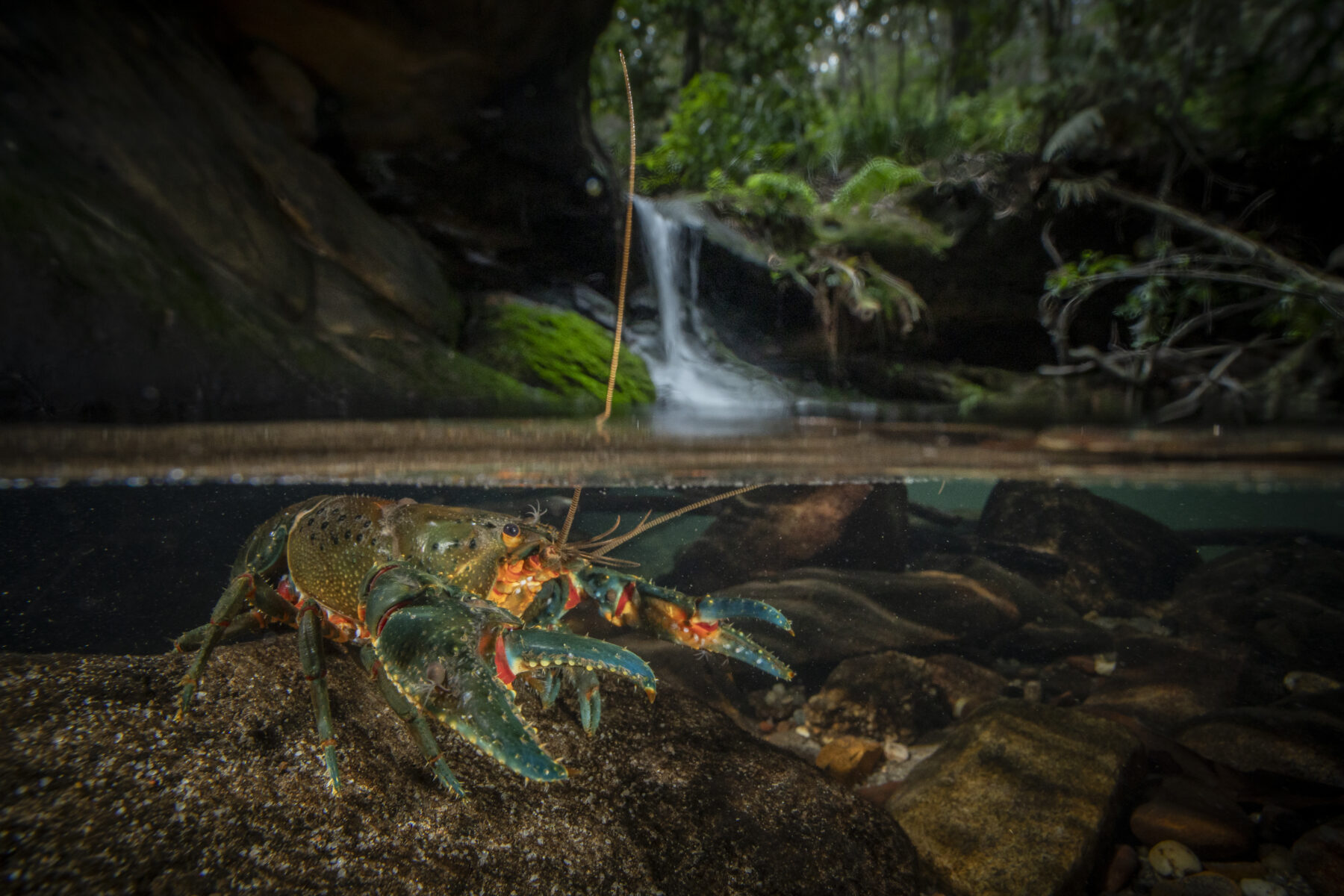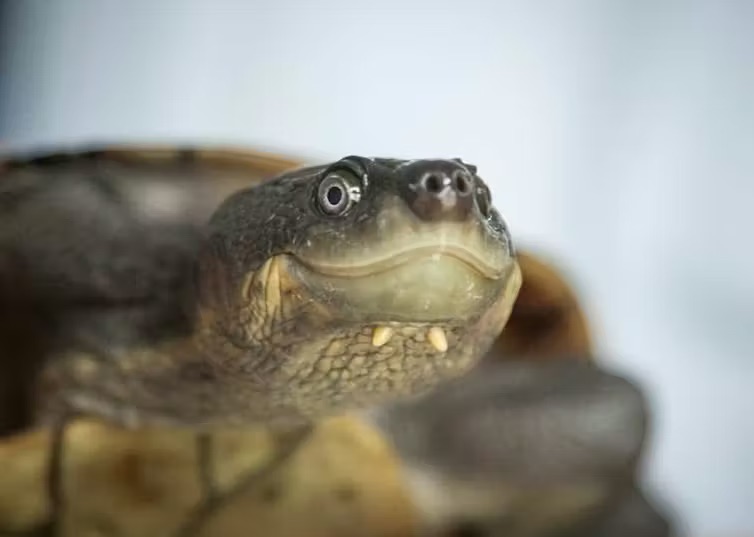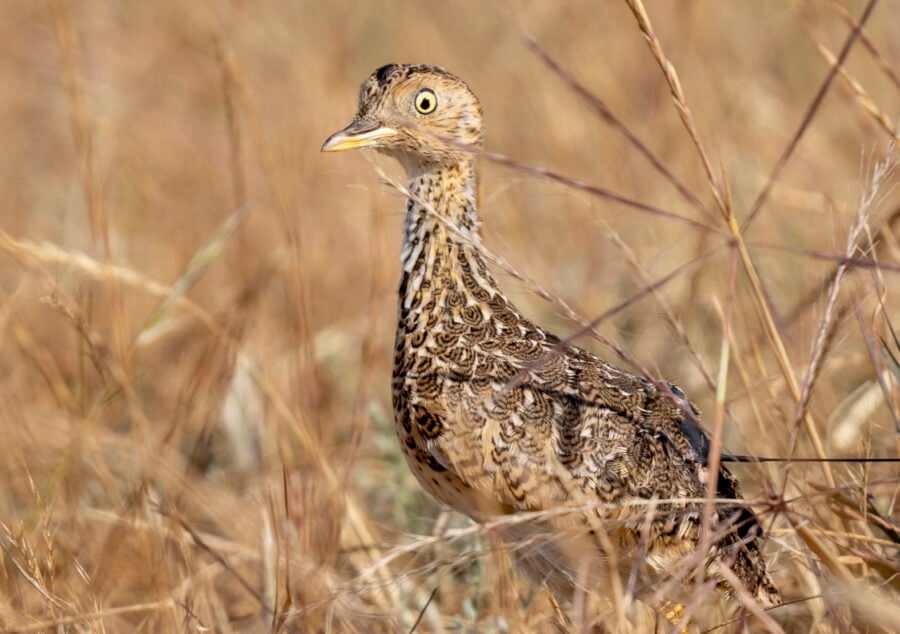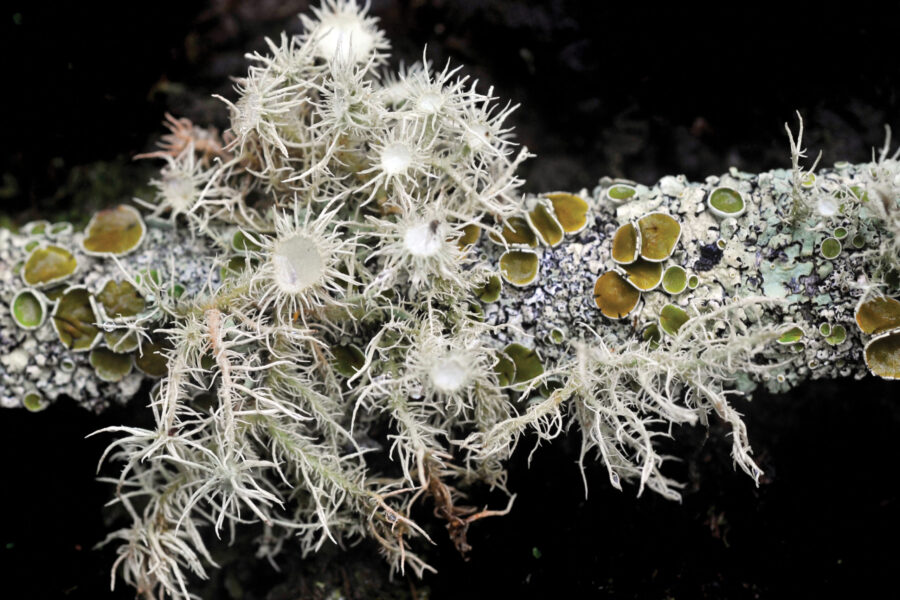Below the subtropical rainforest canopy of the Illawarra escarpment lives a group of secretive and surprisingly stunning creatures that few people are aware of. But if you know what to look for, there are telltale signs of their presence in creeks and streams throughout the forest here – burrows along banks and under rocks, each with a small pile of excavated dirt and gravel on its doorstep.
I first came across these creatures about a decade ago while exploring the area with a friend. “If you’re getting into underwater photography,” he told me, “you need to see these beasts.” We were making our way along a creek when he suddenly became excited and pointed out something moving in a shallow pool. At first glance it resembled a yabby, but closer inspection revealed subtle colours and unusual spines. It was the first time I’d laid eyes on a freshwater spiny crayfish, and I’ve been enraptured ever since.
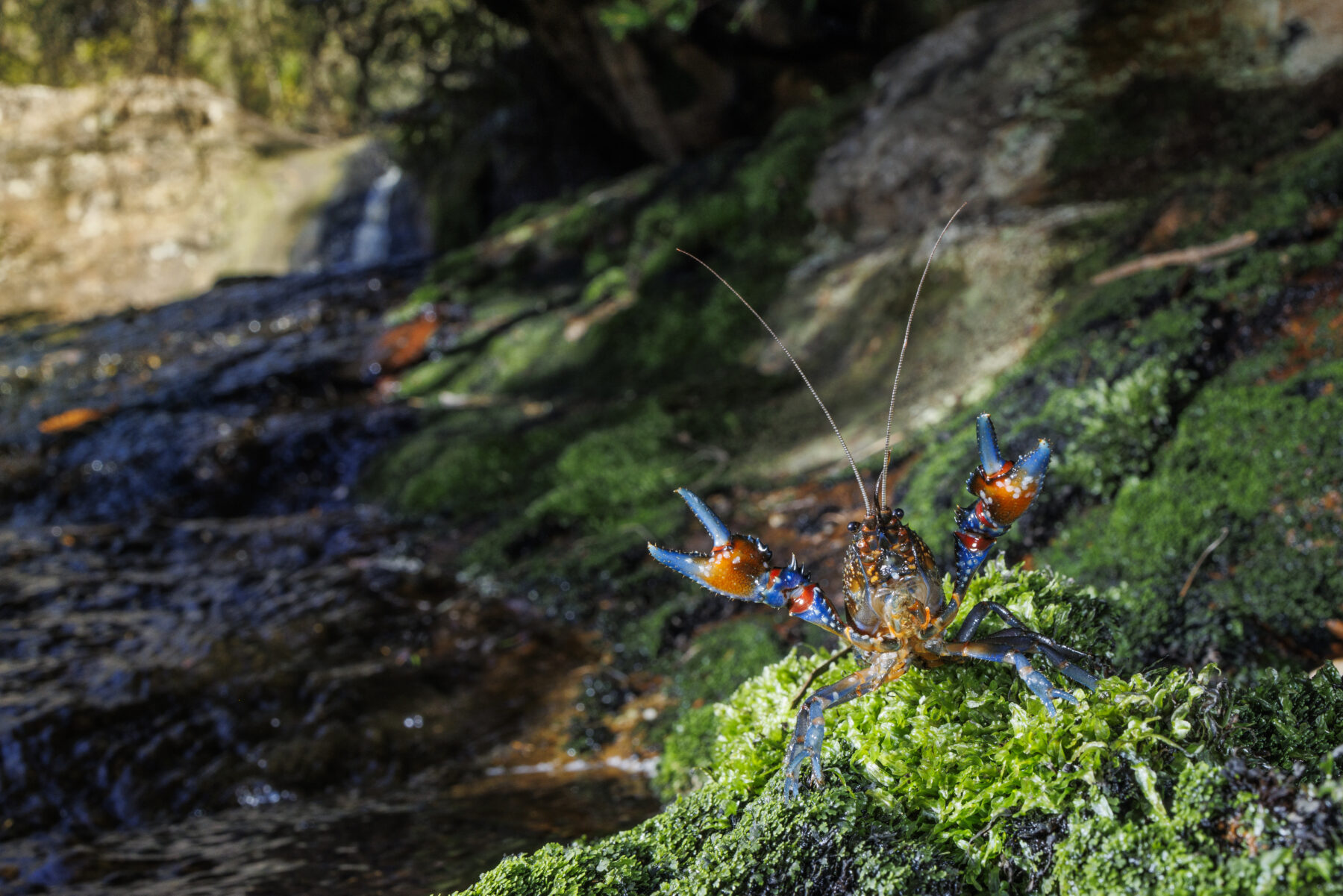
This one was Euastacus hirsutus, sometimes known as the southern hairy crayfish. As far as spiny crayfish go, it’s actually quite unremarkable – not the largest or most vibrantly coloured, but it’s special to me. It’s one of the few animals endemic to the region where I’ve made my home, only found along that narrow stretch of escarpment south of Sydney. In fact, this striking little freshwater crustacean is found nowhere else in the world, let alone Australia. Its presence gives me a sense of place.
There are presently 56 known and scientifically described species of spiny crayfish (although that’s undoubtedly a fraction of what the number really is) – all in the genus Euastacus, the largest of 10 freshwater crayfish genera native to Australia. Spiny crayfish are almost exclusively restricted to cool, wet regions of the Great Dividing Range, where they inhabit a variety of ecosystems, from the lush mountain streams of north Queensland to the freezing alpine bogs of Mt Kosciuszko. The group varies greatly in colour and size, ranging from small species that live in marginal streams, to the largest – the mighty and intimidating Murray crayfish (E. armatus), which wanders the turbid waters of the Murray River and can weigh more than 2.5kg. Our Illawarra spiny crayfish is somewhere in the middle, about the size of a small yabby – the creature most Aussies think of when they hear the term freshwater crustacean.
A mysterious group
For such a diverse genus that’s so widespread along Australia’s populated east coast, spiny crayfish are shrouded in mystery. Rob McCormack, one of Australia’s pre-eminent freshwater crayfish experts, believes many spiny crayfish species are still unknown to western science. “They’re out there. They just need people to find and describe them,” says Rob, the founder of the Australian Crayfish Project.
Rob has dedicated his life (and, he jokes, his children’s inheritance) to the study of Australia’s crayfish, driven by the sense of discovery that comes from studying the unknown and underappreciated. “Places like America are [currently] the most diverse with around 360 species of freshwater crayfish. In Australia we’ve got around 156, but I think we’ve got the potential to outstrip America,” Rob says. “I like to go to a spot that no-one has ever gone to and find what’s there.” Although, he adds, new discoveries aren’t limited to remote places. Sometimes all it takes is going to a familiar area with a fresh set of eyes. “I’m going to places like Lamington National Park [south of Brisbane], where researchers have been going for 100 years, and I’m finding new species.”

Chatting to Rob, I realise our passions stem from a similar place. I’ve always been attracted to obscure subjects, loving the idea of showing people something they didn’t know was there. Showcasing these beautiful crayfish within their idyllic habitats provides a totally new perspective on an ecosystem that’s usually seen from above and masked by reflections
and ripples.
‘Spinies’ have nestled into their creeks and streams, separated for millennia by canyons, waterfalls and lower, drier drainages. This has led to the evolution of a wealth of unique and often ‘localised’ species – some restricted to just a single stream.
Unfortunately, smaller, isolated populations put a species at greater risk of extinction. For example, the critically endangered Fitzroy Falls spiny crayfish (E. dharawalus) is only found in a single creek. Since colonisation, much of the land surrounding the creek has been converted from rainforest into agricultural land. Invasive species such as trout and carp – and even the common yabby (Cherax destructor), which is native to Australia but can be problematic outside of its range – have been introduced into the system. And a reservoir was built in the 1970s that split the whole creek in half. While E. dharawalus does appear to be holding on, a catastrophic event that impacts the entire creek could render the species extinct. For more widespread species, losing one stream’s population may not be that big of a deal – but when that’s your entire distribution, it’s the final nail in the coffin.

Appealing animals
For animals traditionally thought of as having ‘charisma’, crayfish are surprisingly endearing to observe. They move with purpose, ploughing through their streams like mini bulldozers, endlessly working on their burrows and tending to the creek bed. I couldn’t say how many hours I’ve spent sitting on the bank of a clear pool, watching them interact with each other and their environment.
They move with purpose, ploughing through their streams like mini bulldozers, endlessly working on their burrows.
Dr Sarah O’Hea Miller, an aquatic ecologist, took cray-watching to the next level for her PhD. She attached mini radio-tracker backpacks onto several Fitzroy Falls spiny crayfish to track their daily movements and checked in with the tagged individuals hourly during 24-hour periods. Her work has provided fascinating insights into the secret life of the spiny cray.
“You definitely get to know them,” Sarah says. “You’re like, ‘Oh, yeah, this is the lazy one that goes maybe two metres out of his burrow and then goes back to it pretty quickly’, [while other] individuals could have a very defined routine. I remember Crayfish 14 would go for a wander upstream about 10 metres every day, have a little forage, and then she’d be back in her burrow by 4 o’clock.”
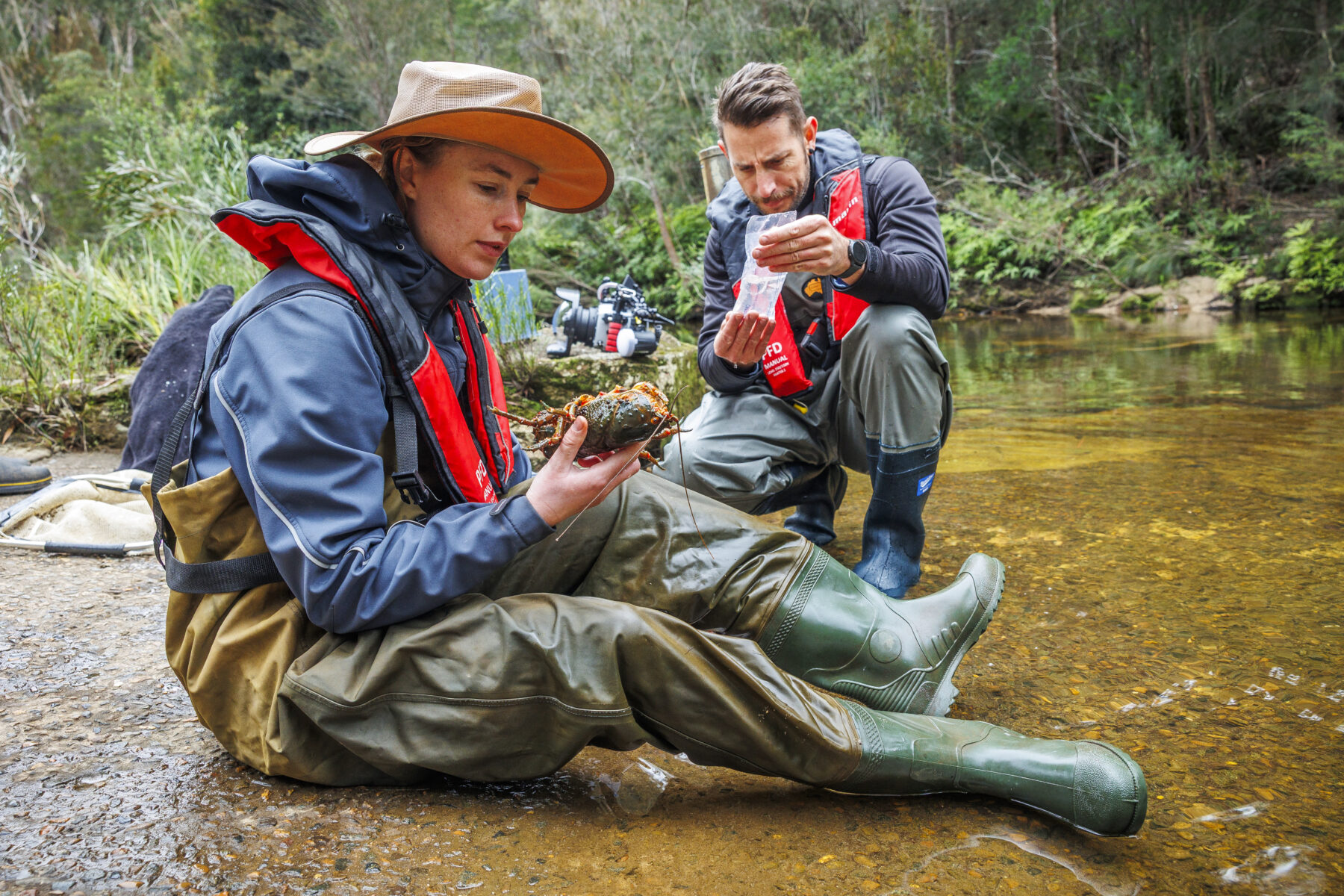
Sarah has been spreading her passion for spiny crayfish at her current job with the NSW Department of Climate Change, Energy, the Environment and Water. She and her colleague Daniel Coleman are leading an exciting, new, first-of-its-kind study. The project hopes to fill in major knowledge gaps about the habitat requirements of another spiny species – the giant spiny crayfish (E. spinifer) – a spectacular and large crayfish with a widespread distribution from the NSW Mid North Coast down to southern Sydney. “We want to determine if there are impacts of water regulation, like dams, on crayfish populations, and if these impacts might be addressed with environmental flow rules,” Dan explains as the three of us wade through a creek in Dharawal National Park, about 45km south of Sydney, throwing out baited traps as part of a routine survey.
“We just assume that Euastacus need flow, because you don’t really see them in dams and they’re hard to keep in aquariums,” Sarah adds. “But we don’t actually have a solid knowledge of their flow requirements. So, this is the starting point for understanding that.”
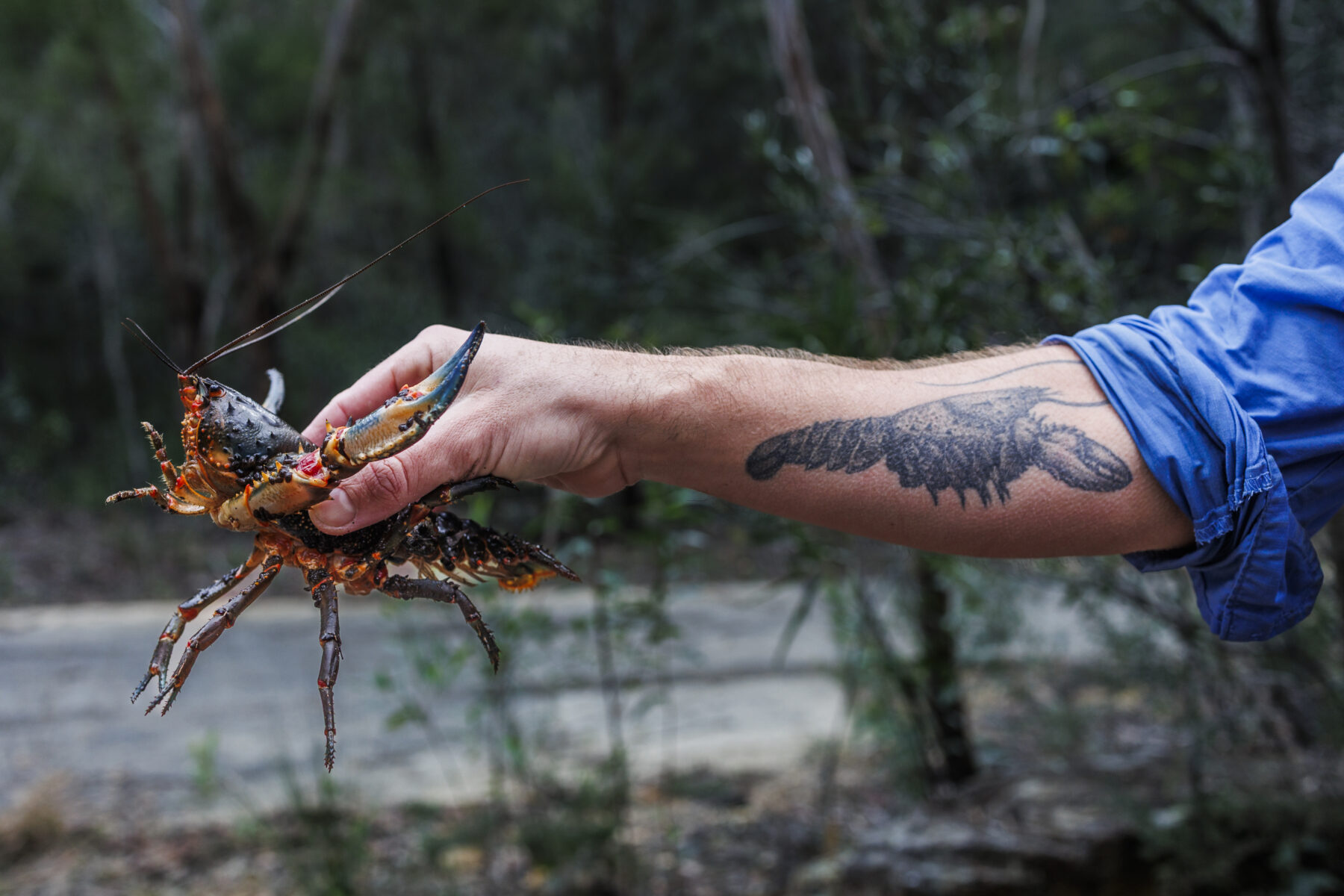
The freezing winter water isn’t enough to cool our excitement as we set out to check the traps after a 60-minute wait. We’re like kids on Christmas morning once we pull in impressive big crays from the deeper pools. The giant spiny crayfish is a common but remarkable species that I never tire of seeing. When they get to a large size (historical records show they can reach more than 1.5kg), they’re truly magnificent – each one with unique, striking colours that can be markedly different between individuals.
The crayfish are weighed, measured, sexed and then returned to the creek, having contributed to Sarah and Dan’s growing dataset. The team has now deployed waterproof acoustic receivers that collect data from tracked crayfish 24/7, only requiring sporadic battery changes and data downloads instead of all-nighters and hourly check-ins.
Understanding something is key to conserving it, and it’s crucial that we conserve freshwater crayfish because they’re considered keystone species – meaning they play a vital role in their ecosystem and many other species rely on their prosperity for survival. Importantly, ‘spinies’ are the creek clean-up crew, eating almost anything they can get their claws on. “They’ll gnaw at timber, roots, leaves – they’re cleaning up and converting the rotten, sludgy vegetation into a food source,” Rob says.
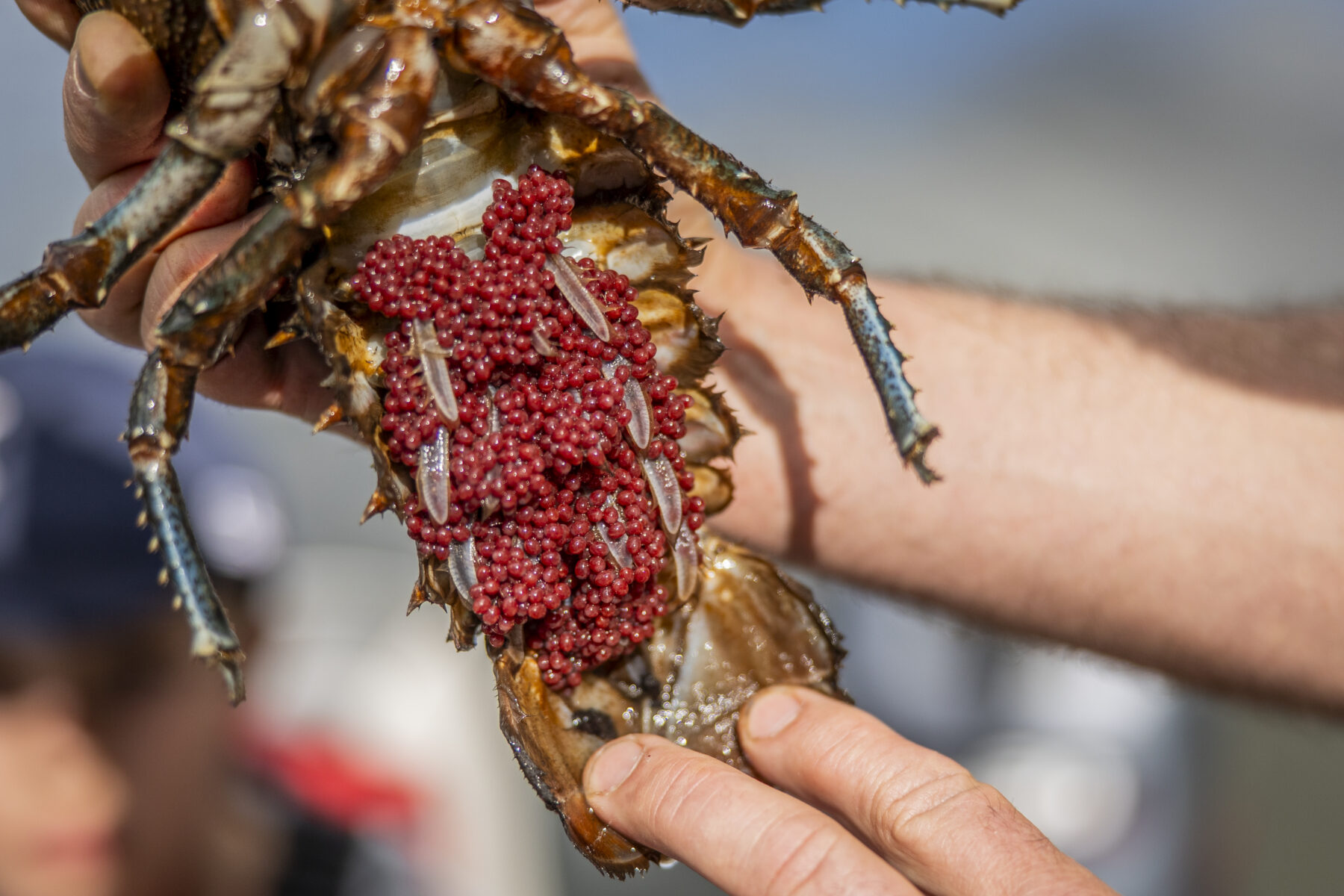
In the headwater streams of the Gold Coast hinterland, the Lamington spiny crayfish (E. sulcatus) is known to play a key role in cycling nutrients, maintaining water quality and processing leaf litter. Crayfish activity such as burrowing also increases habitat complexity, creating additional niches that frogs, insects, lizards and fish can use.
Crayfish also feed their creek. After mating, an adult female carries hundreds of fertilised eggs around with her, curled up in her tail. At this stage she’s known as a ‘berried’ female, as the eggs resemble clusters of berries. After a few months the eggs hatch into miniature spiny crayfish, which eventually disperse to fend for themselves.
“These young are the food source that drives the river system. The fish, eels, turtles, water dragons, platypus, water rats; everything relies on the yearly bounty of this crayfish production system that’s punching all this food into the river system,” Rob says. “There are hundreds of these adult females [each] having 500 to 1000 young each year. The more healthy the adults are, the more healthy the whole ecosystem and all the animals that rely on that food source.”
Not yabbies
Spiny crayfish are often mistaken for common yabbies, which devalues their rich diversity and can sadly result in endangered species being trapped and consumed by an unaware public.
To be clear: yabbies are a type of crayfish, but spiny crayfish are not yabbies. Yabbies are fast-growing and short-lived, typically reaching sexual maturity within 12 months. Spiny crays, in comparison, take about 7–9 years to reach sexual maturity, and individuals can live for several decades. Adults are the backbone of the crayfish production system, yet these are often targeted by humans.
Spinies are the creek clean-up crew, eating almost anything they can get their claws on.
Overexploitation isn’t the only threat facing spiny crayfish. Habitat loss and alteration, invasive species, disease and stream contamination pose significant risks. Climate change is a major concern, and spiny crayfish were among the lesser-known casualties of the 2019–20 Black Summer bushfires, which exacerbated declines that were already occurring throughout the preceding drought. The Murray cray – a species once so abundant there was a commercial fishing industry centred around it – has suffered considerable declines and is now extinct from its historical range in South Australia, although reintroductions in some areas are underway.
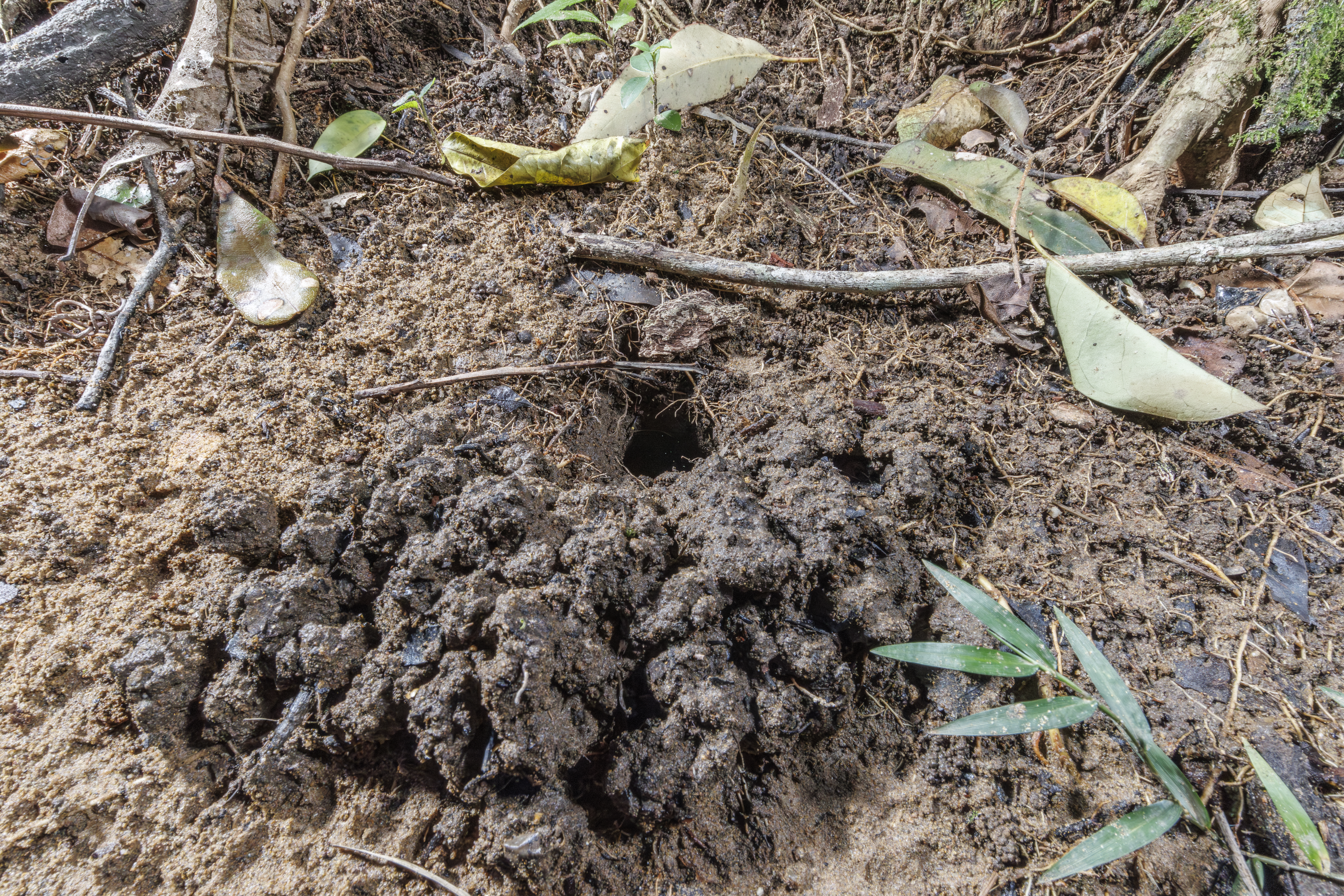
And if, as Rob says, many of Australia’s freshwater crayfish species remain undiscovered, it’s possible we could be losing species before we even know they exist.
Still, it’s exciting to think about all the new and beautiful crayfish yet to be described by Western science, and the opportunity presented for us to understand and cherish something of immense value to our freshwater ecosystems.
Consider the southern hairy crayfish, the Illawarra local that ignited my passion nearly a decade ago. Recent genetic analysis has revealed it’s likely to be two species, split between its northern and southern distributions. That means the northern species, which is the one I would have observed, might be getting a new name. Could it be the ‘northern southern hairy crayfish’? I’ll wait with bated breath.
